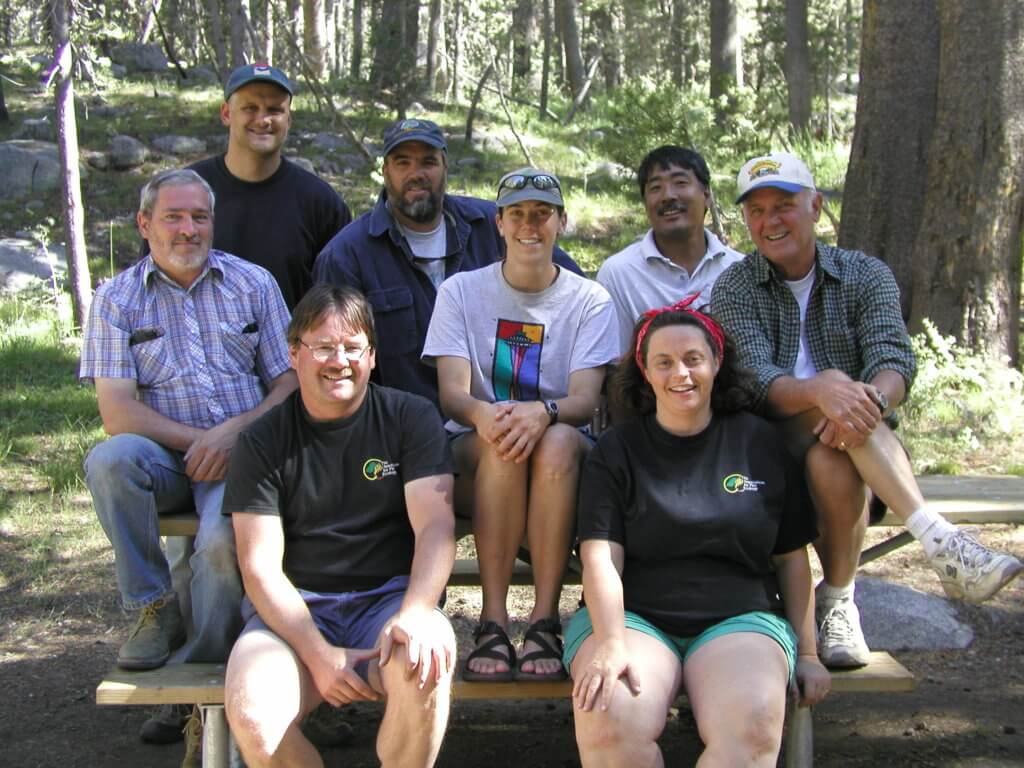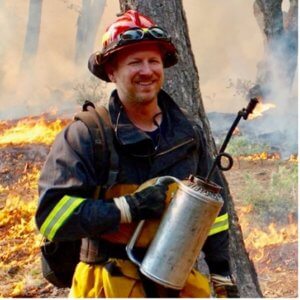AFE, IAWF SHARE COMMON GOALS FOR DIVERSITY, EDUCATION, CO-OPERATION
By Christopher Dicus
I will soon step down as president of the Association for Fire Ecology (AFE) after serving for four wonderful years, handing the reins over to US Forest Service research landscape ecologist Paul Hessburg. As I consider the 15 years I spent on AFE’s board, I am incredibly pleased that AFE and the IAWF have maintain a mutually beneficial relationship through the years. Indeed, many on the AFE board of directors are also members of IAWF and regularly attend its conferences. Both associations work tirelessly to support the wildland fire community, and because each has had unique initiatives and focuses, wildland fire professionals across the globe have been rewarded with a larger breadth of knowledge to best manage undeveloped lands than could have been provided by a single organization.
Like IAWF, AFE has long understood that we must cultivate a continuous pipeline of passionate, well-informed students because the world will continue to be confronted by increasingly complex wildland fire problems. These future fire managers and scientists must have the knowledge, skills, and abilities to change the unfortunate course that we as a society seem to be on at present. Given the large global wildfire challenges, both organizations have key contributions to make to supporting the fire community and it continues to be imperative that both associations work together toward the collective good of both memberships.
AFE, which includes membership on every continent except Antarctica, is focused on building and supporting the diverse community of wildland fire ecologists and managers. Its genesis occurred in 1997 when a group of six researchers and land managers first met at the University of California – Davis. The original intent of this group was to simply form a community that shared a common interest in fire ecology. From this initial meeting, a simple goal of founding a fire ecology working group was formed, which was called the California Association for Fire Ecology (CAFE).

As CAFE continued to meet and discuss fire issues and concerns of the day, it partnered with UC–Davis to take the message of science-based fire management to the masses. To that end, the partnership initiated a series of annual conferences held in San Diego beginning in 1997 that deliberated a diverse array of topics, including fire ecology, management, technology, policy, and others.
Further, CAFE initiated a series of short-courses open to the public in 1998 that aimed to provide a nexus between fire scientists and the land managers who could implement the very principles and best practices that their research had uncovered. Unfortunately, while a great deal of interest was generated, attendance by land management agencies was low, and it was decided to discontinue the sessions after only two years due to the enormous amount of work required, which was provided exclusively by CAFE volunteers.
From these early efforts, which exceeded expectations by most, the loosely knit CAFE working group resolved to create a formal, legal non-profit organization that included officers, bylaws, and board of directors. This result was the creation of the newly named Association for Fire Ecology in 2000.
PROMOTING FIRE RESEARCH
Like IAWF, AFE has from its beginning promoted science-based fire management to facilitate healthy, resilient ecosystems. To that end, in 2000 the newly formalized AFE partnered with IAWF, Tall Timbers, the Joint Fire Science Program, and the Nature Conservancy to hold the First National Congress on Fire Ecology, Prevention, and Management. Purposefully intended to be of interest to a broad audience, the Congress garnered more than 1,200 attendees from 25 countries, which to date is still the largest meeting ever sponsored by AFE.
Following the success and momentum of the 2000 Congress, subsequent international congresses have been held every two to three years, alternating between sites in the western and eastern United States. At every conference, complimentary registration is now provided to a number of local fire managers to better inform their land management strategies, as well as to better inform scientists of managers’ needs.
In 2005, AFE established the journal Fire Ecology to broaden the fire-focused scientific literature. in 2005. The new refereed journal was intended to complement IAWF’s International Journal of Wildland Fire, which at the time seemed by some to focus more on fire management (versus fire ecology) issues. To make sometimes complex science more assessable to a broader audience, current Journal editor Bob Keane recently initiated a series of light-hearted, but informative podcasts that focus on specific manuscripts that have recently been published, which can be found on the AFE website (https://fireecology.org).
In addition to the Journal, AFE also published the textbook Fire in California’s Ecosystems in 2006. Now in its second edition, the text is regularly used in numerous university courses outside of California because of its applicability to a large array of ecosystems and subdisciplines such as impacts of climate change and fire behavior.
PROMOTING FIRE EDUCATION
At the time that AFE was being formalized, a diverse group of students from UC–Davis and UC–Berkeley established the Student Association for Fire Ecology (SAFE) in 2000. While myriad academic disciplines were initially represented, all shared a common goal of effectively understanding and managing wildland fire. SAFE is now officially recognized at 21 universities across the United States and organizes events for fellow students at all AFE conferences.
To facilitate SAFE’s work, AFE annually awards grants to SAFE chapters to fund equipment and travel that facilitates real-world experience with prescribed fire and other activities. Additionally, because AFE wanted to acknowledge and empower future leaders in wildland fire, SAFE now has a seat with voting privileges on AFE’s board. SAFE’s insight has proven invaluable to discussions about potential initiatives that further the wildland fire community. AFE has also recently initiated a new official mentoring program that matches student (and new professional) applicants with long-established fire professionals based upon common interests. The mentoring program is intended to provide young professionals with insights on how to best navigate a successful career focused on wildland fire.
With increasing focus (and subsequent jobs) becoming available in the wildland fire realm, AFE recognized a need for fire ecologists and managers to be acknowledged for their distinctive skill sets. To that end, AFE formalized a Wildland Fire Certification program in 2011, which includes various types of certifications for both managers and scientists who focus on wildland fire and fuel management, the level of which is based on previous education and professional experience. It has been interesting to witness some recent job postings that have specifically listed AFE certification as evidence of an applicant’s qualifications.
In addition to individual certification, AFE also recognizes nine universities in the United States that meet educational standards in various subject matter areas germane to wildland fire. Graduates from these programs are automatically entitled to obtain individual certification at the entry level.
Because of the historic lack of university programs focused on wildland fire (which is happily increasing), the certification program now recognizes certain agency-sponsored courses as meeting educational requirements for individual certification. Further, because certification has historically focused on the educational system in the United States, discussions are underway to formalize pathways for certification in other areas of the world.
FUTURE ASPIRATIONS
As I step down from AFE’s presidency, I look forward to observing the continued good will and partnerships between AFE and IAWF. To that end, both associations have designated official liaisons who attend board meetings of the other association. These positions have been extremely beneficial to both organizations because the liaisons share lessons learned for similar types of initiatives and best practices for certain types of events. Further, the liaisons notify the other association of upcoming plans so as not to step on the toes of the other in terms of scheduling.
A primary goal during my presidency was to increase international participation in AFE. To that end, the AFE board elected 50 per cent of our executive board from outside the United States (Spain and Mexico). Further, we continue to plan (in partnership with the Pau Costa Foundation) for a conference to be held in Florence, Italy, in fall 2022 to meet the needs of our European colleagues. While COVID-19 has frustratingly delayed the meeting for two full years, we are fully committed to having our first conference in Europe and hope to do similar meetings on other continents.
We also aspire to have a greater presence with fire managers who are doing the good work on the front lines, for whom much of the science is geared. While we hope to guide management with sound science, it is imperative that management guides scientific efforts to be relevant in an increasing complex world.
Finally, I hope both associations continue to diversify their memberships, in terms of not only gender, ethnicity, and nationality, but also personal philosophies. In a world that is increasingly divided (and regrettably hostile to opposing views), both associations should aspire for their membership to enjoy a feeling of belonging regardless of their personal worldview and not just fit in, the latter of which necessitates people to modify their identities to feel accepted by their peers. Indeed, members in both associations (and society in general) would benefit from an increasing sense of mutual respect, even when our personal views differ on a given subject.
ABOUT THE AUTHOR
 Chris Dicus is a professor and co-ordinator of the Wildland Fire and Fuels Management Program at California Polytechnic State University. Dr. Dicus is the current president of the Association for Fire Ecology (having served on the board since 2006) and is also co-ordinator of the Wildland Urban Interface Module of the California Fire Science Consortium. His research focuses on the wildland urban interface and how fuel treatments impact potential fire behavior and ecosystem services. Dicus obtained his B.S. in forestry-wildlife from Louisiana Tech University, an M.S. focusing on fire ecology from Utah State University, and a PhD focusing on silviculture from Louisiana State University. He is a certified senior wildland fire ecologist and a California-registered professional forester.
Chris Dicus is a professor and co-ordinator of the Wildland Fire and Fuels Management Program at California Polytechnic State University. Dr. Dicus is the current president of the Association for Fire Ecology (having served on the board since 2006) and is also co-ordinator of the Wildland Urban Interface Module of the California Fire Science Consortium. His research focuses on the wildland urban interface and how fuel treatments impact potential fire behavior and ecosystem services. Dicus obtained his B.S. in forestry-wildlife from Louisiana Tech University, an M.S. focusing on fire ecology from Utah State University, and a PhD focusing on silviculture from Louisiana State University. He is a certified senior wildland fire ecologist and a California-registered professional forester.
